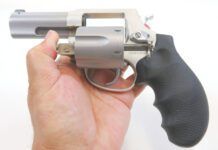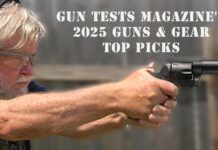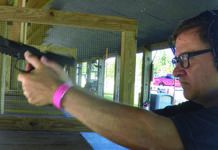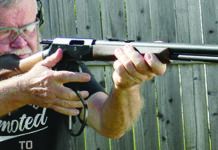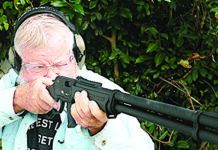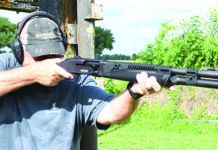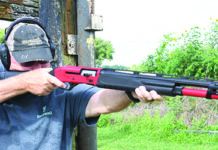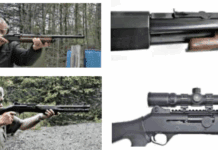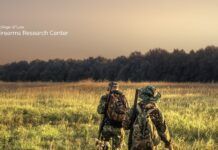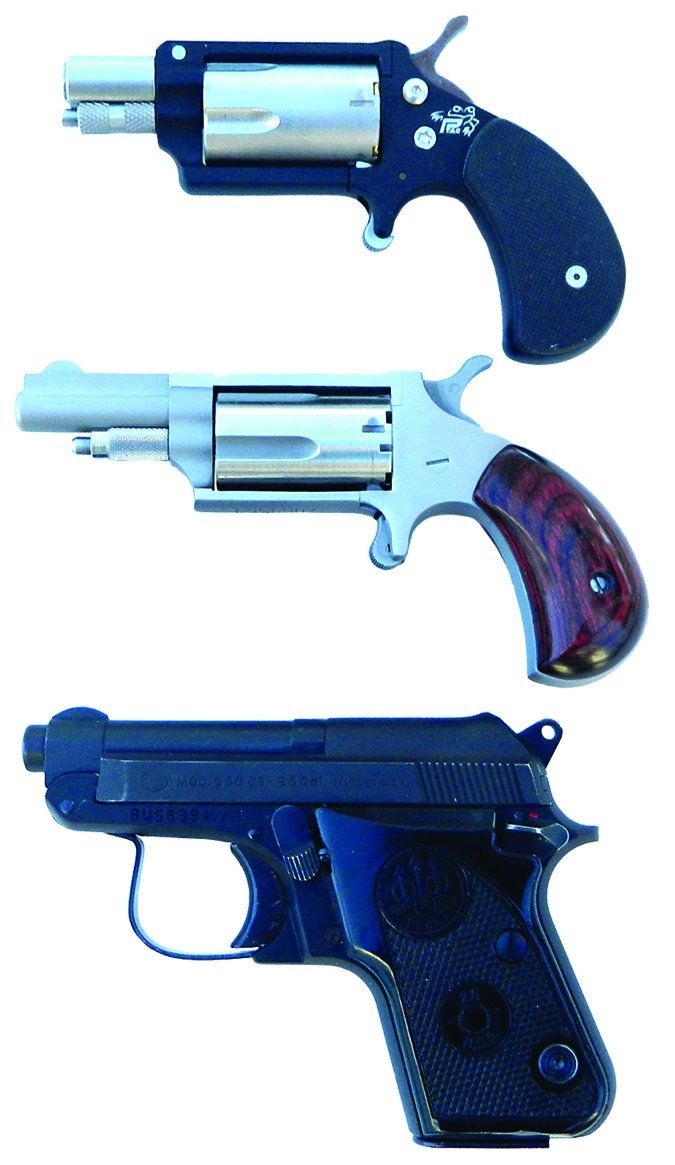
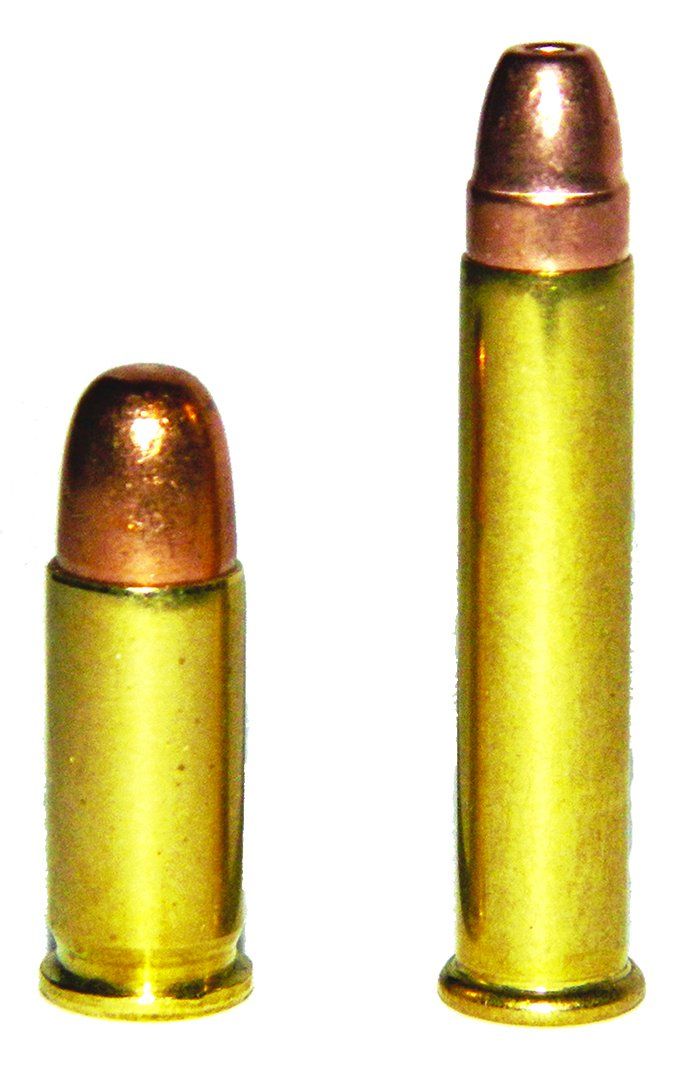
Love them or despise them, mouse guns — aka very small pocket pistols — are an important part of the self-defense landscape by virtue of their sheer numbers. For example, the North American Arms Mini Revolver is a popular handgun that has created a niche all its own. It is offered in several versions, with relatively long barrels as well as the traditional short barrel. We were interested in what type of accuracy a trained shooter could wring out of the Mini Revolver because a 6.5-ounce 22 Magnum just might have appeal as a pocket revolver or backup. We also tested a newcomer and competitor to the Mini Revolver. The PTAC Bullfrog is a copy of the NAA revolver in some ways but is mechanically different in others. We also added a small automatic pistol to the test. The Beretta 950 25 ACP handgun is a widely used pistol and can be called a standard among pocket pistols. For safety, each of the revolvers and the Beretta self-loader demand that the hammer be cocked before the pistol may be fired. Each also features a single-action trigger, although the revolvers must be cocked for each shot. In the end, we thought one gun offers a good-enough chance at stopping hostile action, but to be frank, members of our team would still be reluctant to buy it.
25 ACP and 22 Magnum Load Performance Data
| North American Arms 22M w/1.6 in. barrel | Average Velocity (fps) | Muzzle Energy (ft.-lbs.) | Average Accuracy (in.) | Power Factor (pf) | Expanded Width (in.) | Retained Weight (gr.) | Penetration in Water (in.) |
| 22 Magnum Fiocchi 40-gr. JSP | 1050 | 98 | 4 | 42 | 0.22 | 40/100% | 16 |
| 22 Magnum CCI 40-gr. JHP | 903 | 72 | 3.5 | 36 | 0.24 | 40/100% | 14 |
| 22 Magnum Hornady 45-gr. FTX | 968 | 94 | 4.1 | 43 | 0.60 | 44/99% | 12 |
| Beretta 950 BS Jetfire w/2.4 in. barrel | |||||||
| 25 ACP Aguila 50-gr. FMJ | 730 | 59 | 2.9 | 37 | 0.25 | 50/100% | 14 |
| 25 ACP Hornady 35-gr. XTP | 935 | 68 | 2.5 | 33 | 0.30 | 34/99% | 8 |
| Notes: Average Velocity and standard deviation readings were obtained by firing four five-shot strings over a Competition Electronics Pro Chrono. The PTAC Bullfrog was omitted from accuracy testing because the accuracy was so poor we could not reasonably control our shots. Ambient temperature: 68 degrees. Elevation: 815 feet above sea level. l The accuracy figures are the average of two five-shot groups. For accuracy, we fired the test gun from a benchrest at a 15-yard target. l To calculate IPSC power factor, multiply bullet weight in grains by the velocity in fps, then divide by 1000. l The retained-weight column shows the recovered bullet weight as a percentage of the actual bullet weight. We did not do accuracy and chronograph testing of the PTAC Bullfrog because of safety considerations. | |||||||
| Loads tested: Fiocchi 40-grain Jacketed Soft Point 22 Magnum, 22.25/50 rounds from BulkAmmo.com; CCI 40-grain Jacketed Hollow Point 22 Magnum, $11/50 from SportsmansGuide.com; Hornady 45-grain FTX 22 Magnum, $15.19/50 from SportsmansGuide.com; Aguila 50-grain Full Metal Jacket 25 ACP, $22/50 from LuckyGunner.com; Hornady 35-grain XTP 90012, $17.79/25 from MidwayUSA.com. | |||||||
North American Arms 22M 22 Magnum, $220
GUN TESTS GRADE: A
The NAA revolver is small but well made. The revolver was reliable and useful. We were able to make hits far past bad-breath range, and the revolver functioned properly without difficulty. It isn’t our first choice for self defense, but it is a viable deep-cover hideout or backup revolver.
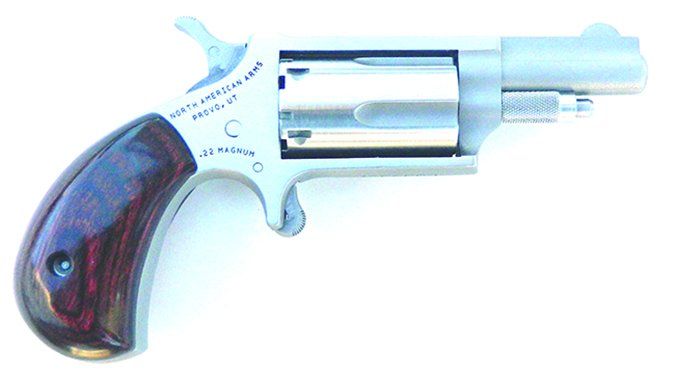
| ACTION | Single-action revolver |
| OVERALL LENGTH | 5.1 in. |
| OVERALL HEIGHT | 2.9 in. |
| MAX WIDTH | 1.06 in. |
| WEIGHT UNLOADED | 6.5 oz. |
| WEIGHT LOADED | 7.5 oz. |
| BARREL LENGTH | 1.6 in. |
| BARREL | Steel |
| CAPACITY | 5 |
| FRAME | Stainless steel |
| FRAME FRONT STRAP HEIGHT | 1.6 in. |
| FRAME BACK STRAP HEIGHT | 2 in. |
| GRIPS | Rosewood |
| GRIP THICKNESS (max) | 1 in. |
| GRIP CIRCUMFERENCE (max) | 3.3 in. |
| SIGHTS | Fixed |
| TRIGGER PULL WEIGHT (SA) | 6.5 lbs. |
| TRIGGER SPAN (SA) | 2.1 in. |
| SAFETY | None |
| WARRANTY | Lifetime |
| WEBSITE | NorthAmericanArms.com |
| TELEPHONE | (800) 821-5783 |
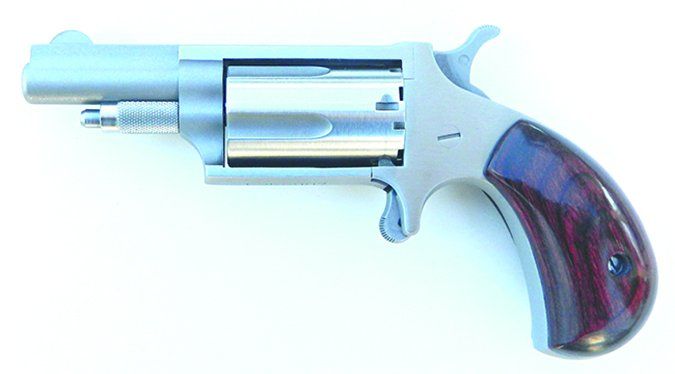
This was our price at SCGUNCO.com, and for that money, the NAA 22M came with a nice locking metal gunbox that is large enough to hold two mini revolvers. We liked this very much. There are several options with the North American revolver. One of these is to order a version with a spare 22 LR cylinder for inexpensive practice. This is okay as far as it goes, but we all agreed we would not be doing a lot of practice with this revolver. It isn’t difficult or painful to shoot, but the loading manual of arms simply doesn’t invite extensive range work. There are longer barrels and also larger and smaller grips.
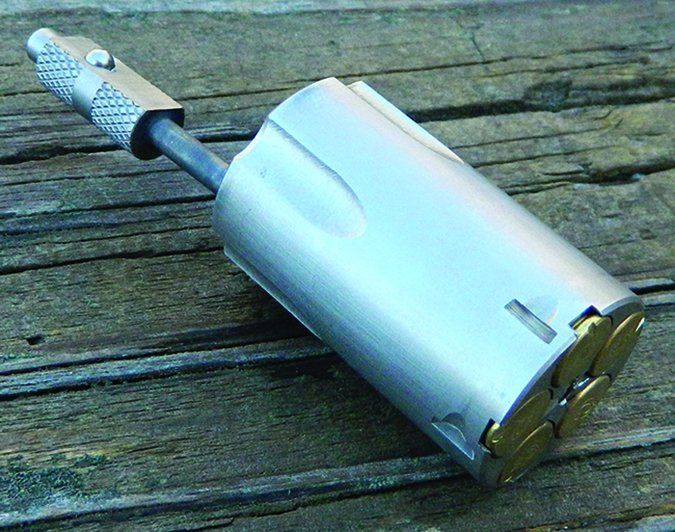
The 22M tested is a type of default NAA revolver and the one we felt was most practical. The trigger is single action, which means the revolver much be cocked for each shot. The trigger is a simple spur type. To load the revolver, the cylinder pin is removed and the cylinder is pressed out of the frame. Five cartridges are loaded and the cylinder is replaced and the cylinder pin lined up and locked in place. Once the cylinder is replaced, the user determines how he wishes to carry the revolver. You cannot simply allow the firing pin to rest on the cartridge. There are two options. One is to slightly bring the hammer to the rear and allow the hammer to rest in the safety notch. This isn’t a half-cock notch, but is instead a safety notch built into the hammer. This seems safe enough. The second one is preferred by our raters. There are notches between the chambers. The firing pin may be lowered to ride in this notch, preventing the hammer nose from riding on a cartridge. You have to remember to place the revolver in the safe mode, which is acceptable, but there is nothing to impede drawing and firing the revolver. You simply draw and fire; there is no manual safety as the revolver is transitioned from Safe mode to Fire mode.
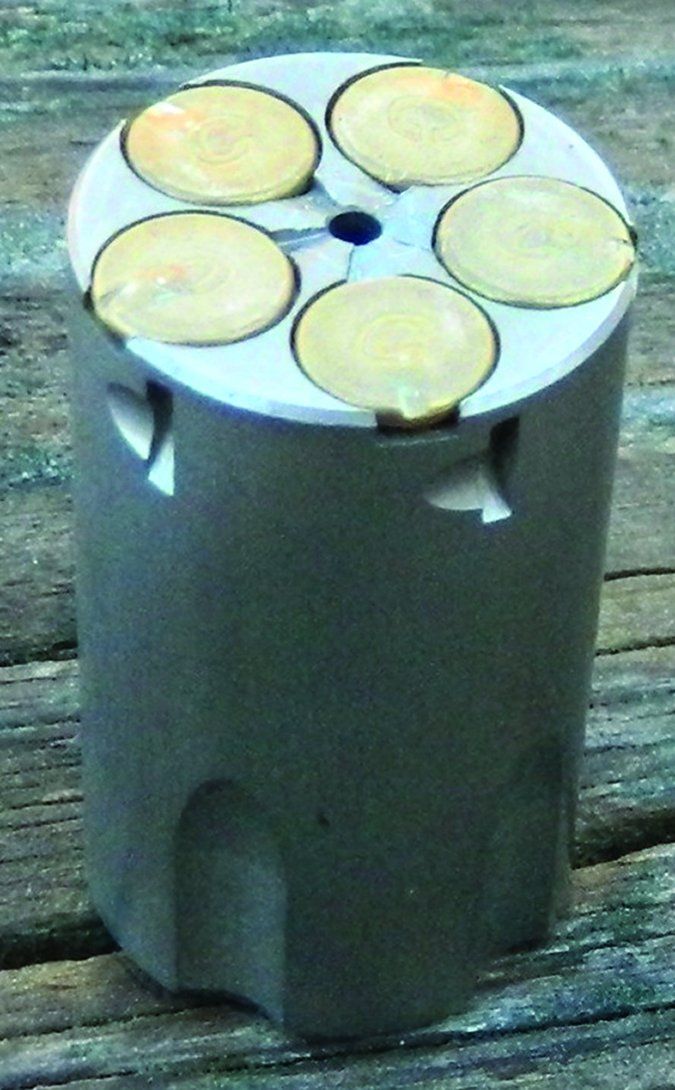
To unload the revolver after firing, the cylinder is removed and the spent cases are pressed out one at a time with the cylinder pin. We never had any difficulty pressing the spent cartridge cases from the cylinders. The rear sight is a simple notch in a raised portion of the frame. The front sight is a half moon. Surprisingly, the sights were visible when the revolver was properly held. Our best firing technique for accuracy was to hold the revolver in the strong hand high enough for the sights to be visible. The hammer is cocked with the support-hand thumb. Some will have difficulty simply holding and firing the revolver properly, but it can be done with sufficient practice. We had no difficulty firing the revolver, quickly, with one hand, but it simply wasn’t as accurate. The NAA 22M was fired offhand at an attacker-sized target at a distance of 5 yards. We used the Fiocchi 40-grain JSP, the CCI Maxi Mag 40-grain round, and the Hornady 45-grain FTX loads in testing. We were surprised to find that we could make a 4-inch group at 5 yards, sometimes a bit smaller with concentration. The front sight really stood out and helped in getting a solid aim on the target. We fired from the benchrest at 7 yards, printing a group with each load. There was no difference to speak of in accuracy, as the shooter simply had to try to manage the trigger. The trigger breaks at 6 pounds, which isn’t heavy but pulling much weight against a 6-ounce revolver is difficult. We fired groups averaging 3 to 4 inches at 7 yards, certainly not worthless performance from such a small handgun. We believe that with sufficient practice by the owner, the revolver may have some merit against large reptiles on the trail.
We experienced a single failure to fire with CCI 22 Magnum load. The cartridge was removed from the chamber and displayed a good primer strike. It was replaced in the cylinder and rotated so that a different part of the case rim would be exposed to a strike. The second whack of the firing pin fired the revolver. Such is the occasional event with rimfire loads.
Our Team Said: The NAA 22M does what it is designed to do and does it well.
PTAC Bullfrog 1.125-Inch Barrel, $294
GUN TESTS GRADE: D-
Stuff shooting out from the revolver stung our cheeks, even with the revolver held at full extension, and this isn’t acceptable. There was also a problem with either pressure or rough chambers because empties stuck in the chambers. It was not wise to continue shooting this firearm, so we stopped.
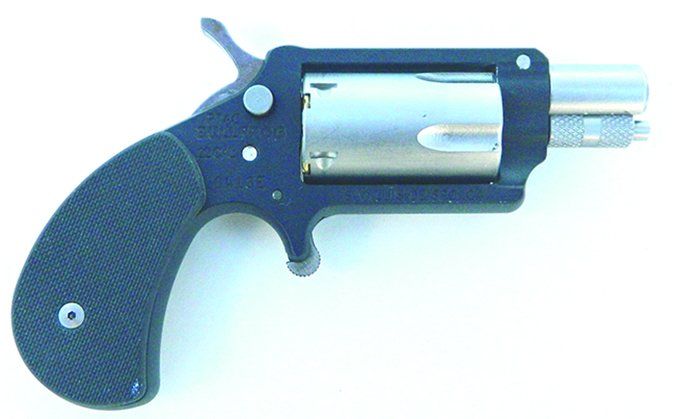
| ACTION | Single action revolver |
| OVERALL LENGTH | 4.5 in. |
| OVERALL HEIGHT | 2.6 in. |
| MAX WIDTH | 1.06 in. |
| WEIGHT UNLOADED | 5 oz. |
| WEIGHT LOADED | 6 oz. |
| BARREL LENGTH | 1.125 in. |
| BARREL | Steel |
| CAPACITY | 5 |
| FRAME | Aluminum |
| FRAME FRONT STRAP HEIGHT | 1.5 in. |
| FRAME BACK STRAP HEIGHT | 2 in. |
| GRIPS | G10 |
| GRIP THICKNESS (max) | 0.8 in. |
| GRIP CIRCUMFERENCE (max) | 3 in. |
| SIGHTS | Fixed rear, no front sight |
| TRIGGER PULL WEIGHT (SA) | 7 lbs. |
| TRIGGER SPAN (SA) | 2 in. |
| SAFETY | Manual safety |
| WARRANTY | 1 year |
| TELEPHONE | (805) 668-5851 |
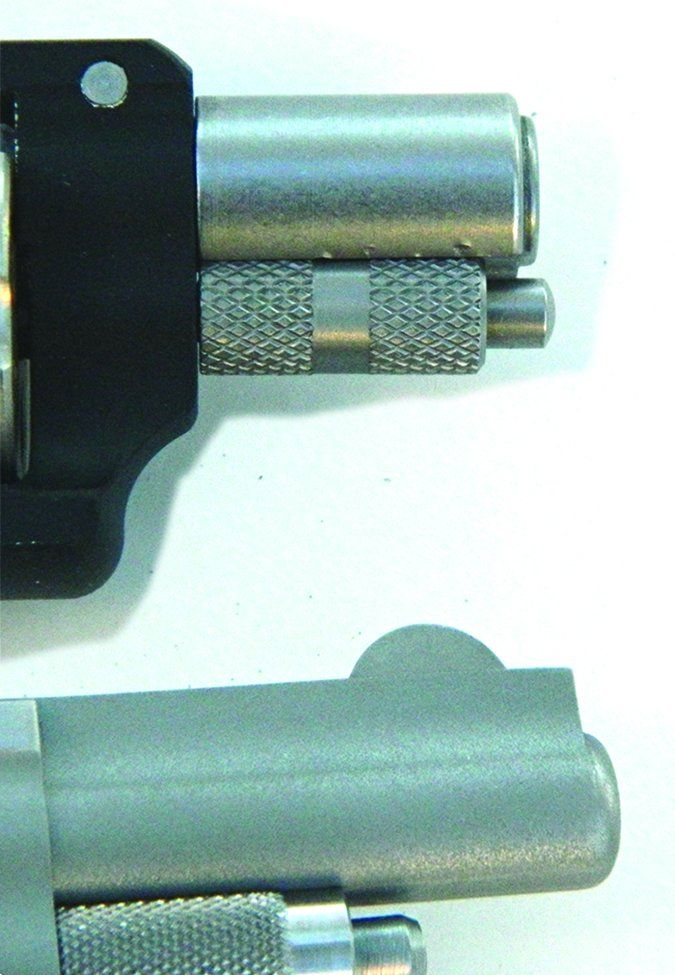
The Bullfrog is usually available for about $57 more than the NAA 22M, a search of internet prices found. We did not compare the prices of the versions for either revolver with both the 22 LR and the 22 Magnum cylinders. The Bullfrog is delivered in a small clamshell plastic box. The Bullfrog should offer an advantage over the NAA 22M revolver for this price hike. To the contrary, we found a revolver with significant demerits compared to the NAA 22M. The Bullfrog’s frame is black-anodized aluminum. The grips are checkered G10 material. Each is modern and acceptable. Weight is saved with the aluminum frame, and the G10 grips give good purchase. The revolver has no safety notch in the action as exists in the NAA revolver. Also, there are no cuts in the cylinder to rest the hammer nose. The Bullfrog uses a pushbutton safety that is applied with the hammer cocked. A bolt is moved left to right and the hammer lowered into a notch in the safety. The revolver may be cocked and the trigger pressed, but the hammer will fall onto the safety bar and not reach the cartridge when the safety is applied. To fire, the hammer is cocked and the safety lever pushed to the left by the trigger finger. Left-hand shooters need not apply. There is simply too much going on that works against simple readiness. To first cock the handgun and then press the safety button is too awkward for one-hand manipulation. We also foresee a safety issue if the cocked revolver is wallowing in the hand while we manipulate the safety.
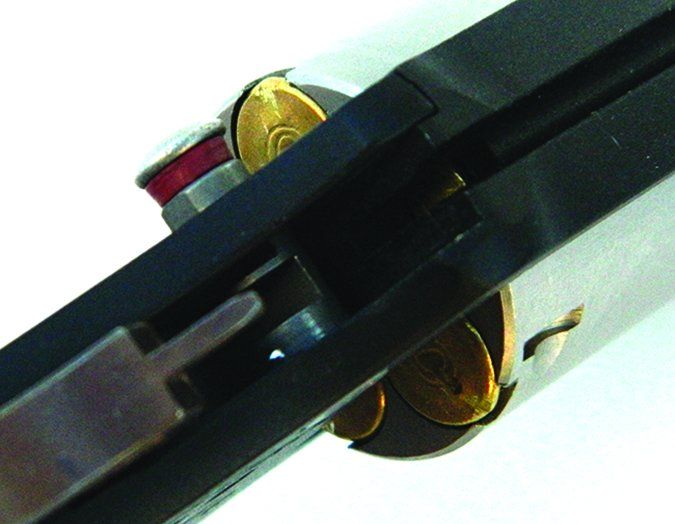
The trigger of the Bullfrog breaks at 7 pounds. The revolver was comfortable enough to fire. However, when firing the first round, we were stung on the cheeks by some type of ejecta. There was no powder on the face and no blood, no evidence of any powder or lead projectiles, but we certainly felt it. Always wear safety glasses! No matter if you’re shooting a hundred-dollar gun or a thousand-dollar gun, our first shot is fired into the berm at close range and the hand is at full extension. Firing in this manner is how we first felt the stinging ejecta. We were glad the gun wasn’t closer to the face.
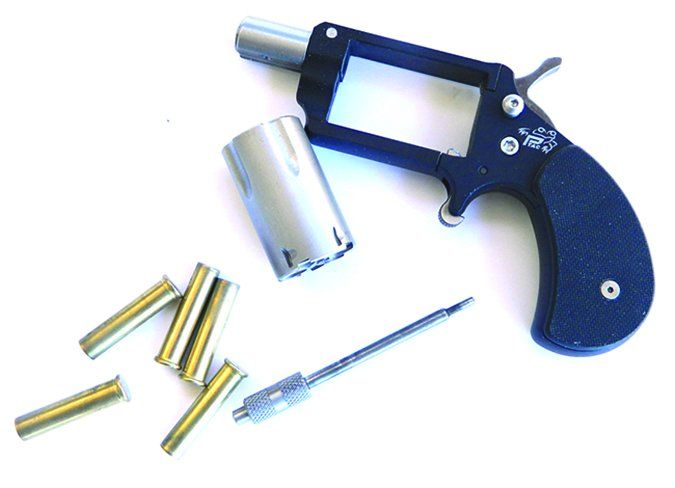
The rear sight, or, rather, the only sight, is a trough in the top of the strap. We liked this rear-sight design better than the NAA, but there was a big defect—there is no front sight. We were unable to find a range at which we could connect with the target past about 5 feet. Even then, the point of aim could not be repeated with each effort. Results were extremely poor. With each shot we felt what may have been unburned powder from the short barrel or perhaps something from the barrel and cylinder gap. Yet the gap between the cylinder and forcing cone seemed as tight as the NAA 22M. Each revolver had some fore and aft play, but less when cocked. The Bullfrog did not lock quite as tightly as the NAA 22M when the hammer was cocked, but it was close. When at rest with the hammer down, there was no difference in the play of the cylinder that we could determine. We were unable to produce any type of reliable hit on the target past a few feet. Eliminating the front sight is a serious design flaw, in our estimation. As we saw with the NAA 22M, this size of revolver is capable of reasonable accuracy in a short-range defensive situation.
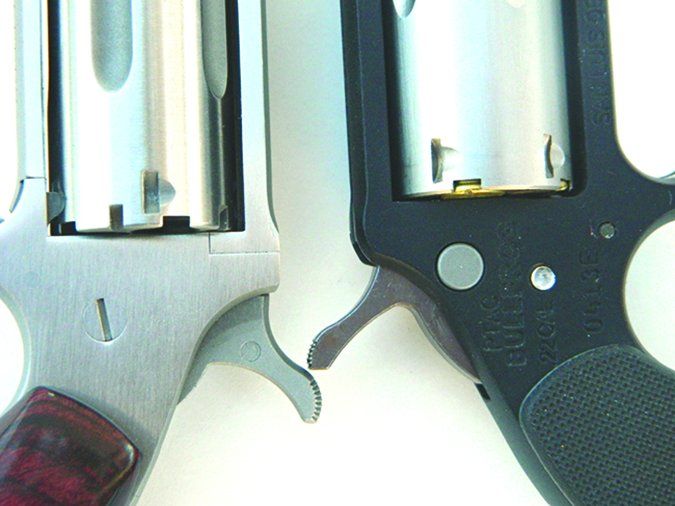
As we unloaded the revolver, we were faced with another dilemma. The fired Fiocchi cartridge cases were stuck tight in the cylinders. We were forced to take a cleaning rod and ram the cartridge cases out with considerable effort. Whether the revolver would not take the pressure of the 22 Magnums or whether the cylinders were simply rough, we could not ascertain. After ramming the spent cartridges out and reloading with CCI 22 Magnum loads, the revolver was fired again. This time the senior rater told the crew to fire into the ground a few feet in front of the revolver. Again, the cartridges were stuck in the cylinder. The senior rater then called a halt on the testing.
Our Team Said: The ejecta from the revolver was stinging our cheeks, even with the revolver held at full extension, and this isn’t acceptable. Second, there was a significant problem with either pressure or rough chambers, and this isn’t good. It was not wise to continue shooting. Finally, accuracy was so poor we could not reasonably control our shots, and it was not wise to continue trying to hit the target with this revolver. We would not buy the Bullfrog.
Beretta 950 BS Jetfire 25 ACP, $285
GUN TESTS GRADE: A-
The pistol came out of the box firing without any reliability issues. The accuracy potential of this handgun is greater than the NAA 22M, an important point. The Beretta also offers 8+1 25 ACP rounds, a significant difference between the self loader and the two five-shot revolvers. As a gun, we like the Beretta. The big problem is a deficit in power.
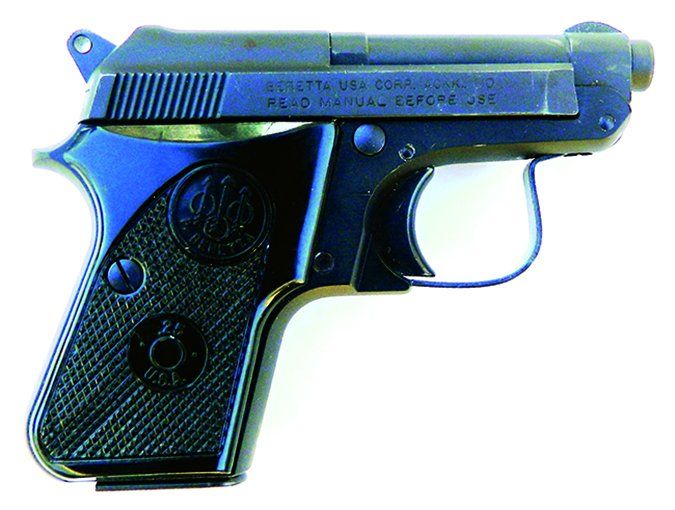
| ACTION | Locked breech, single action semi-auto |
| OVERALL LENGTH | 4.7 in. |
| OVERALL HEIGHT | 3.4 in. |
| MAX WIDTH | 0.9 in. |
| WEIGHT UNLOADED | 10 oz. |
| WEIGHT LOADED | 12 oz. |
| BARREL LENGTH | 2.4 in. |
| BARREL | Steel |
| MAGAZINE | 8-rd. detachable box |
| SLIDE | Steel |
| FRAME | Aluminum |
| FRAME FRONT STRAP HEIGHT | 1.6 in. |
| FRAME BACK STRAP HEIGHT | 2.4 in. |
| GRIPS | Plastic |
| GRIP THICKNESS (max) | 0.9 in. |
| GRIP CIRCUMFERENCE (max) | 4.5 in. |
| SIGHTS | Fixed |
| TRIGGER PULL WEIGHT (SA) | 5.9 lbs. |
| TRIGGER SPAN (SA) | 2.3 in. |
| SAFETY | Lever |
| WARRANTY | None |
| WEBSITE | Beretta.com |
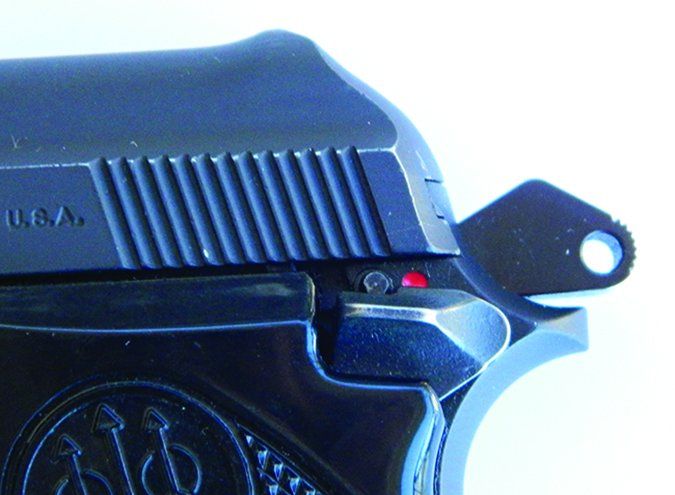
The Beretta 950 Jetfire is a single-action self-loader chambered for the 25 ACP cartridge. The Beretta 950 has been widely used as a cop’s backup and a pocket pistol for civilians. The pistol features a matte finish that is not unattractive. The grips are checkered plastic. The pistol features a tip-up barrel. By tipping the barrel up and loading straight into the chamber, the slide need not be racked for firing. This also makes unloading more efficient as the cartridge cannot be damaged by unloading. There is no extractor; powder gases blow the spent cartridge case out of the chamber. The pushbutton magazine release is handy to use. The frame-mounted safety may be applied when the hammer is cocked or when the hammer is at rest. Most shooters will prefer to leave the hammer down and on the safety notch. Simply pull the hammer back slightly until it clicks. There is plenty of leverage for cocking the hammer. The plastic grips are properly checkered for good adhesion, which is important in a pocket pistol. The NAA revolver is held securely in the hand largely due to the design of the grips, which works well. The Beretta finds the proper purchase in a different manner.
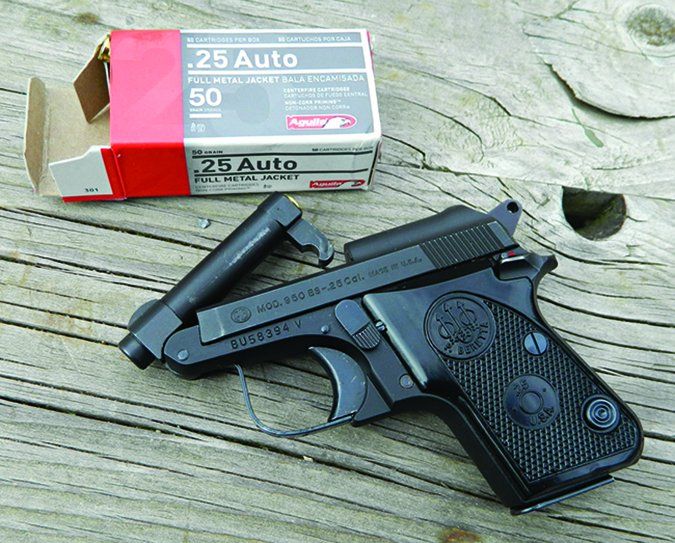
The trigger action is a clean 6 pounds. The Beretta is necessarily taller than the NAA revolver, but no wider, and only a little, if any, more difficult to conceal. Both get on target about as quickly. In handling, the Beretta is a pleasant firearm to use. Using the Aguila 50-grain FMJ and the Hornady 35-grain XTP, firing was pleasant, with five-shot groups of around 2 inches at 7 yards. We felt this was good performance from this type of handgun. The combat target was placed at 15 yards and we found that we could easily get center-zone hits quickly. This is an easy handgun to shoot well and an easy handgun to like. The Beretta never failed to feed, chamber, fire, or eject in firing 50 rounds of the Aguila FMJ load and 40 rounds of the Hornady XTP loading. For what it was designed to do, the Beretta certainly fits the bill.
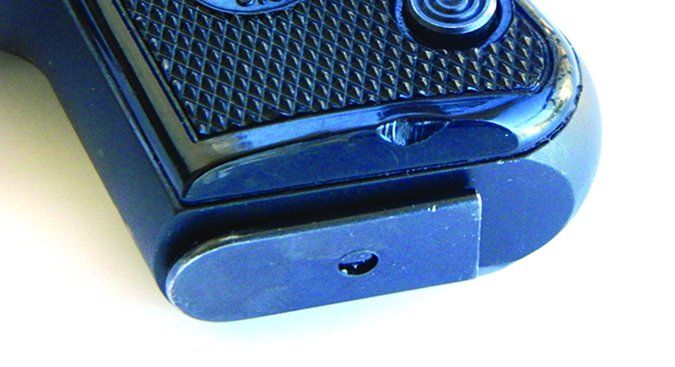
Our Team Said: After range testing, we rated the pistol an A. Then, after carrying the 22M in the pocket and the Beretta in the pocket, sometimes both at once in separate pockets, we rated the Beretta down a half grade when we found that a press on the magazine release could release the magazine in the pocket.
We eliminated the Bullfrog from consideration because of its various problems, so it came down to the NAA revolver versus the Beretta self-loader. Neither handgun fills the bill for personal defense for our shooters. Each has a serious deficit of power. However, as a last-ditch hideout, which is the criteria for which they were designed, each has merit. For the Beretta, some type of holster is usually recommended, but the grip is also exposed with a holster, so this is a consideration. Because the magazine can inadvertently be released, the Beretta would fire only once, and no more, if this had not been discovered. This will not happen with the NAA revolver. Based on overall power and reliability, we have to rate the NAA revolver the better buy.
Written and photographed by Bob Campbell, using evaluations from Gun Tests team testers.



